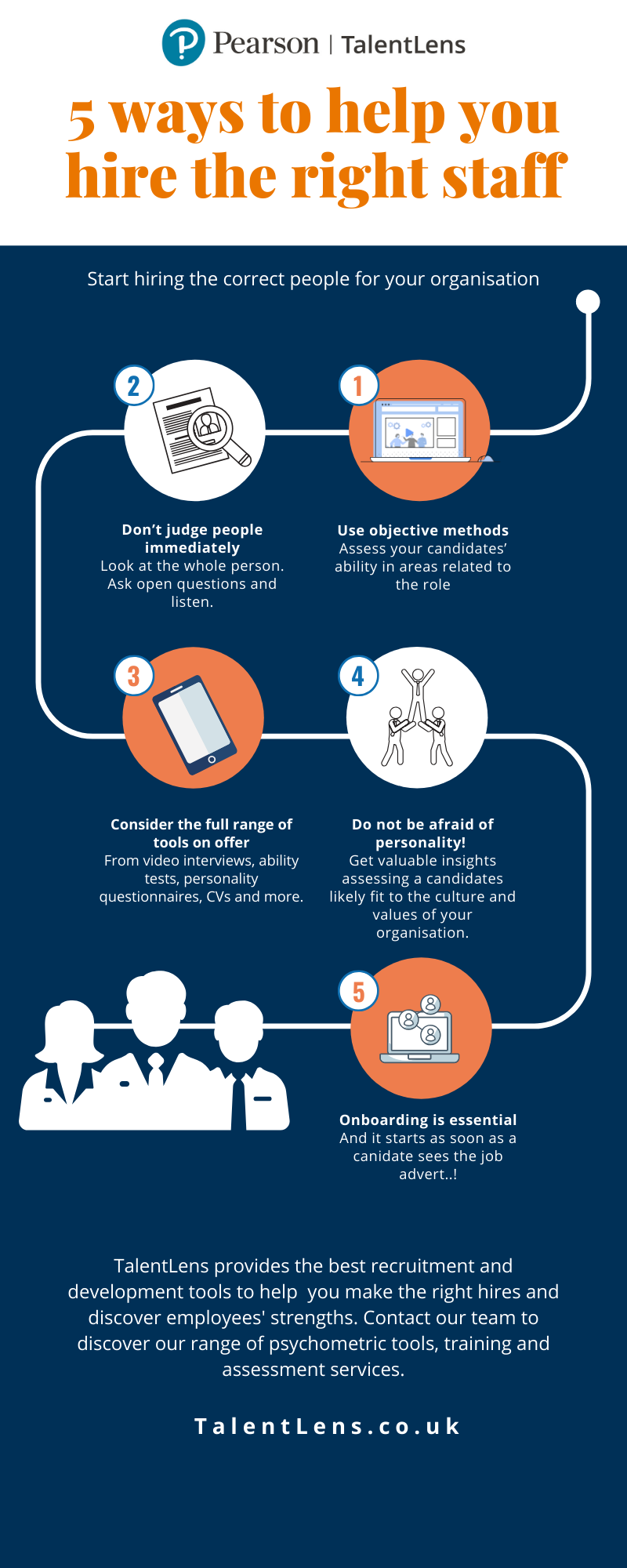5 ways to help you hire the right staff
by

Do you find that your new hires are often not what you expected them to be? Here's 5 tips to help you avoid making mistakes when recruiting.
After careful consideration, examining CVs and a rigorous interview process, you select the best candidate, only to find that they do not seem motivated in the role and are causing disruption and distraction. They may even leave the business much sooner than expected. Why does this happen? What can be done in an attempt to prevent bad hires?
The damage a bad hire causes can be expressed financially – costing (based on current research) around 30% of the final salary of any incoming employee. However costs could be significantly higher if you factor in training costs, and lost productivity. Millennials have proven that they are not afraid to switch jobs and Gen Z are all about independence and being entrepreneurial. As such, hiring and rehiring is a very common problem for recruiters.
Recruitment has been referred to as a game of risk management and probability. Below are five ways you can attempt to tip the balance in your favour and hopefully hire the correct people for your business.

1. Use objective methods
CVs and cover letters are a very common first step during an interview process. Whilst providing invaluable information, they are written by the candidate and as such, are not impartial. Therefore, it is increasingly common to assess your candidates’ ability in areas related to the role – this can be via online tests, sat remotely, typically lasting between 15-30 minutes. By doing this, you obtain an objective and fair representation of candidate skills compared to the competencies of the role. Ability tests have been shown to be second only to assessment centres, in terms of effectiveness when recruiting, with CVs (biodata) in fourth place….
2. Don’t judge people immediately
It is human nature to make a snap judgement about someone almost instantly; whilst intuition and certainly experience can serve people well, again it is not impartial. Therefore, in an interview, it is important to ensure you are looking at the “whole person” in front of you, rather than not being able to look beyond preconceptions. Ask open questions and listen.
3. Consider the full range of tools on offer
There is a vast array of methods to help you hire people: video and phone interviews and assessments, ability tests, assessment centres, personality questionnaires, situational judgement tests, CVs and structured interviews to name but a few. Research what’s out there – referring to our earlier post about the top 5 recruitment methods might be helpful.
4. Do not be afraid of personality!
Whilst ability tests give you a clear representation of your candidates’ aptitude, personality assessment results are less precise. As such, there is more doubt about their effectiveness and sometimes a scepticism about the validity of the results. However, a robust personality assessment can give you valuable information, such as a candidate’ likely fit to the culture and values of your organisation. You may have hired the brightest, most willing candidate but if measures have not been taken to determine what makes them tick, they may well be matched with the wrong role. This can lead to some of the negative behaviours mentioned at the start of this post; even the most conscientious employee will find it hard to remain fully motivated and thus, productive if placed in an environment not compatible with their personality traits and values.
5. Onboarding is essential
This may seem obvious but it is surprising how often people are expected to “just get on with things”, without a rounded induction to the ethos, procedures and expectations of the role, department and wider company. Employees who receive a robust induction programme are likely to stay longer and contribute more to the business. There is a wealth of literature available, illustrating the importance of good onboarding and the negative effects of poor onboarding.
It could also be argued that onboarding starts when someone sees the job ad; so every piece of information you supply to the candidates will help them to construct an impression of the culture of the organisation. The first 90 days of employment is when new employees are most engaged. 93% of employers agree a good onboarding experience is critical – once the employee starts, if they already have a sound appreciation of the business, they are more likely to feel at ease, integrate more smoothly and become productive more quickly. Plus, Process St research shared by The Virtual Hub highlights that “good onboarding improves employee retention by 25% and overall performance by 11%” – never underestimate the importance of a good “onboarding checklist” there are some great examples of what to consider here.
We hope that you find these tips useful! For more information about how TalentLens can help you to recruit and develop your staff, please feel free to contact us.

